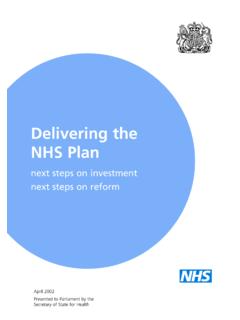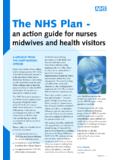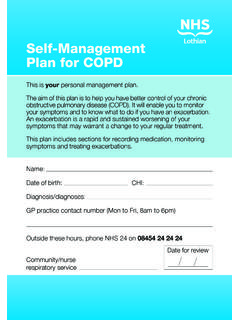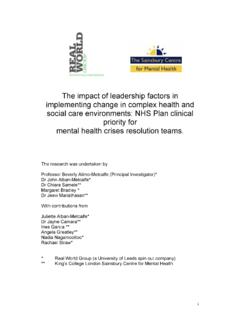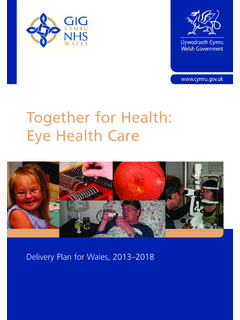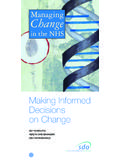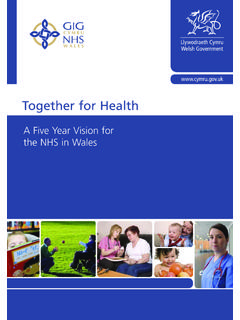Transcription of South East London: Sustainability and Transformation Plan
1 South east london : Sustainability and Transformation Plan21 October 2016 Key information detailsNameof footprint and no: South east london ; no. 30 Region: South east london (Bexley; Bromley; Greenwich; Lambeth; Lewisham; Southwark)Nominated lead of the footprint including organisation/function: Amanda Pritchard, Chief Executive, Guy s and St Thomas NHS FTOrganisations within footprints: CCGs: Bexley; Bromley; Greenwich; Lambeth; Lewisham; SouthwarkLAs: Bexley; Bromley; Greenwich; Lambeth; Lewisham; SouthwarkProviders: Guy s and St Thomas' NHS FT; King s College Hospital NHS FT; Lewisham and Greenwich NHS Trust; South london and Maudsley NHS FT; Oxleas NHS FT.
2 Bromley Healthcare CIC; and primary care providersDartfordand Gravesham NHS Trust are an associate organisation, but formally sit outside of the footprint2 Draft in progress |SectionPageOur challenges and priorities1 plan on a page6 Developing consistent and high quality community based care (CBC) and prevention8 Improving quality and reducing variation18 Improving productivity and quality through provider collaboration30 Optimising specialised services across South east and South London35 Delivering our plan will require a change in how we work38 Bridging our financial gap41 Making progress in 2016/1743 ContentsIn South east london (SEL) we have a history of partnership working.
3 This includes collaborations between commissioners and providers, across health and social care, with the voluntary sector and citizens and with education and research institutions and networks. The six South east london CCGs have in place a well-established collaborative approach, and work with all of london 's 32 CCGs and NHS England to enable Transformation across the capital, including through the Healthy london Partnership (HLP). Providers work together as part of formal and informal clinical networks, including specialised services supported by our King s Health Partner s (KHP) Academic Health Science Centre.
4 Organisations in the footprint also contribute to and use resources developed by support infrastructures such as the Health innovation Network (HIN) and Collaboration for Leadership in Applied Health Research and Care (CLARHC). The provider landscape is changing as we welcome the development of 15 at scale primary care federations covering all of South east CCGs were developing a Transformation strategy previously, the STP process has broadened this and has taken it much further by bringing organisations together to establish a place based leadership and decision making structure (that is, one which focuses on the population of SEL rather than the individual organisations).
5 The aim of this is to collectively identify our priorities and to help ensure that health and care services are built around the needs of plan outlines our collective understanding of the challenges we face and sets out our approach and actions to address date, we have established: A single responsible officer supported by a quartet leadership drawn from local government, commissioners, providers and clinical leadership, and a strategic planning board to provide direction and oversight Collaborative oversight and decision making bodies at various continue to work at.
6 Leadership and governance development, including development of a MOU A single reporting structure bringing transparency across the system The establishment of a single version of the truth setting out our challenges, including our financial have committed to improving services for our residents within the resources available to us. We recognise that the status quo is unsustainable and, in order to deliver the Transformation required, we need to change how we work together to overcome barriers to delivering our shared priorities.
7 Over the next five years we will: Support people to be in control of their physical and mental health and have a greater say in their own care Help people to live independently and know what to do when things go wrong Help communities to support each other Make sure primary care services are sustainable and consistently excellent and have an increased focus on prevention Reduce variation in outcomes and address inequalities by raising the standards in our health services Develop joined up care so that people receive the support they need when they
8 Need it Deliver services that meet the same high quality standards whenever and wherever care is provided Spend our money wisely, to deliver better outcomes and avoid wasteOur commitmentsIntroduction3 Draft in progress |Our challenges and prioritiesLocally, we face many of the challenges that are experienced nationally. The three gaps that are identified in the Five Year Forward View are found in South east london , and our plan will seek to address these. We are clear about the challenges people face in living healthily and wellThe health of our population has improved significantly over the last five years, but there is more to be done.
9 A detailed case for change has been developed to understand the health and wellbeing needs of our population. In summary: We have a vibrant, diverse and mobile population with extremes of deprivation and wealth. 26% of children are classified as living in poverty, concentrated in certain parts of SEL; Premature death and differences in life expectancy are significant issues; 75% of over 55s have at least one LTC, while 32% of children are overweight or obese; We need to improve the health of the population overall. Keeping well, at all ages, is critically have developed a model (below) that segments our population into groups depending on their condition and level of risk, in terms of both physical and mental health.
10 The 50% of our population who are affected by inequalities or are putting their health at risk is too high; ensuring more of our population are enabled to stay well is imperativeto prevent our challenges getting : the financial graphic represents spend per patientWhile we have made progress we can do more as a system to improve our care and quality gapThe quality of care that patients receive too often depends on when and where they access services. We don t consistently meet quality and performance standards, and some providers are not rated good or outstanding by regulators.



